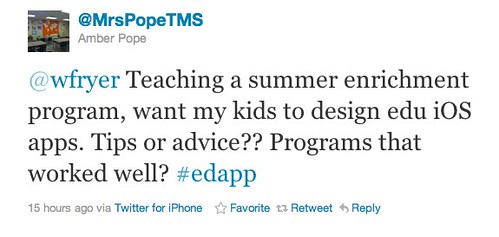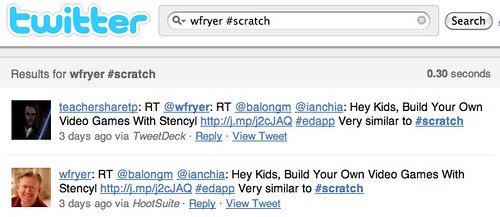I received a tweet last night from Amber Pope, a 7th grade social studies, geography, & civics teacher in Tarrant, Alabama. Amber asked for resource suggestions for students developing iOS / mobile applications in a special summer program she’s leading at her school.
These are the suggestions I provided!
WebKit Open Source Project: This is the tool students at Hong Kong International School used to create an awesome conference application back in September of 2009. More details are available on this archived forum post in the conference Ning. Apparently the HKIS students also used jQTouch:
…a jQuery plugin for mobile web development on the iPhone, Android, iPod Touch, and other forward-thinking devices
A wrote a bit more about this in my September 2009 post, “An Exemplary Interactive Mobile Conference Website (Vision 2020 Conference.)”
App Inventor for Android: Although it’s for Android and not iOS devices, this is a great (and free) mobile app development environment which students can explore and try. It’s browser based. This short video gives a preview of how it works, simple logical programming can be used with an iconic-based interface similar to Scratch.
Speaking of Scratch, I didn’t tweet this to Amber but need to pass it along, I learned recently about Stencyl. It’s a free game-development software program which creates Flash-based programs and is VERY “Scratch-like,” including a similar learning community for project sharing. Currently Stencyl doesn’t port to iOS, but their roadmap includes iOS app development down the road according to Audrey Watters’s May 31st article for Read/Write Web, “Hey Kids, Build Your Own Video Games With Stencyl.”
Incidentally, I learned about Stencyl three days ago via a Tweet from Ian Chia, and found the link to it again today via a Twitter search.
Increasingly I find Twitter serving as an important component of my “offboard brain!”
I also recommended Amber check out Appmakr. I have not used the site’s services yet, but it’s apparently free to try. Their pricing page is less than thorough with pricing costs, however, stating:
This option of our service (building your app initially) is completely FREE, but third party developer account and app store fees may apply. If you are publishing to the iTunes AppStore, Apple’s Application Uploader requires a MAC computer. If you do not have access to a MAC, no worries – we can help!
Anyone know how much app development with Appmakr would REALLY cost?
Heidi Siwak, a 6th grade teacher in Canada, shared a link in response to Amber’s tweet requests for app development resources that might be of interest to others. “21 Century Classroom: The Amaryllis” is described the following way:
Class 62 is currently working on a collaborative real-world project with Ian Chia from Australia: designing an Augmented Reality App for the iphone. We are documenting the entire process. Discussions between Ian, Class 62 and myself can be found in the comments under each post. You can also follow us on twitter @ianchia and @heidisiwak The first post for this project begins in April 2011.
Ian’s wiki, “Where I live – a DIY app” is also available.
There are a lot of different commercial companies offering a “fast track” development process for iOS and other mobile apps as well, which would be good to at least show to students and discuss. Among those I’ve found to date, Mobile Roadie looks like one of the best (it’s used by Taylor Swift for her app, for example) and also MyApp. I haven’t used either of these services and can’t vouch for them at this point.
Besides teaching students about mobile app development, it’s also very important to discuss and learn about the benefits of creating mobile-friendly, HTML5 compatible websites which work on different mobile platforms and have other advantages as well as limitations relative to apps. MobileAP is an open source tool originally developed at the University of Cincinnati I wrote about in that same September 2009 post about the HKIS conference app. MobilAP is open source, which means you and your students can use it free as long as you have access to a compatible web server. This can be a server your school or district runs, or (probably easier although it costs you $$$) a shared hosting server account from a provider like Bluehost or Siteground. (Full disclosure: The previous are affiliate links, we use Siteground for my girls’ webshow, The Zebra Print, and I use Siteground for this blog.)
MIT’s mobile website is one of several exemplary university mobile portals you can show to students, to showcase not only the power of the mobile web but also what is possible to do from an informational perspective as an organization or for an event using webpages as well as custom mobile apps.
What have I left off this list? I’m particularly interested in FREE mobile app development resources which could be used by students. Thanks for contributing your ideas and links!
Technorati Tags:
android, app, apple, apps, development, ios, mobile, students, software
If you enjoyed this post and found it useful, subscribe to Wes’ free newsletter. Check out Wes’ video tutorial library, “Playing with Media.” Information about more ways to learn with Dr. Wesley Fryer are available on wesfryer.com/after.
On this day..
- Visualizing Inside and Outside Sharing – 2016
- Digital Neighborhood Watch (Nextdoor.com) & Model Use of Twitter by Local Police – 2015
- How to Archive a KidBlog Website – 2014
- What We Can Learn from Oklahoma’s Repeal of Common Core – 2014
- Fun with Visual Charades and Narrated Slideshows Based on Fairy Tales – 2012
- Yesvideo.com converts analog media to digital – 2010
- Flickr now displays video formatted for #ipad – 2010
- Preparing for a week of Travian sitting – 2009
- Public Service Announcements To Combat Meth – 2009
- Weblin Meet-Up Results and Revisited – 2008



Comments
3 responses to “Resources for Students Developing Mobile Apps #edapp”
Suggestion from Matthew Needleman: The Mac app Hype, available in the Mac App Store:
http://tumultco.com/hype/
http://gamesalad.com/ looks great too – this from Amber Pope in another tweet. 🙂
I am teaching year 8 to 12 students to build apps using CoronaSDK. I am documenting our journey for those interested at ramblingteacher.blogspot.com